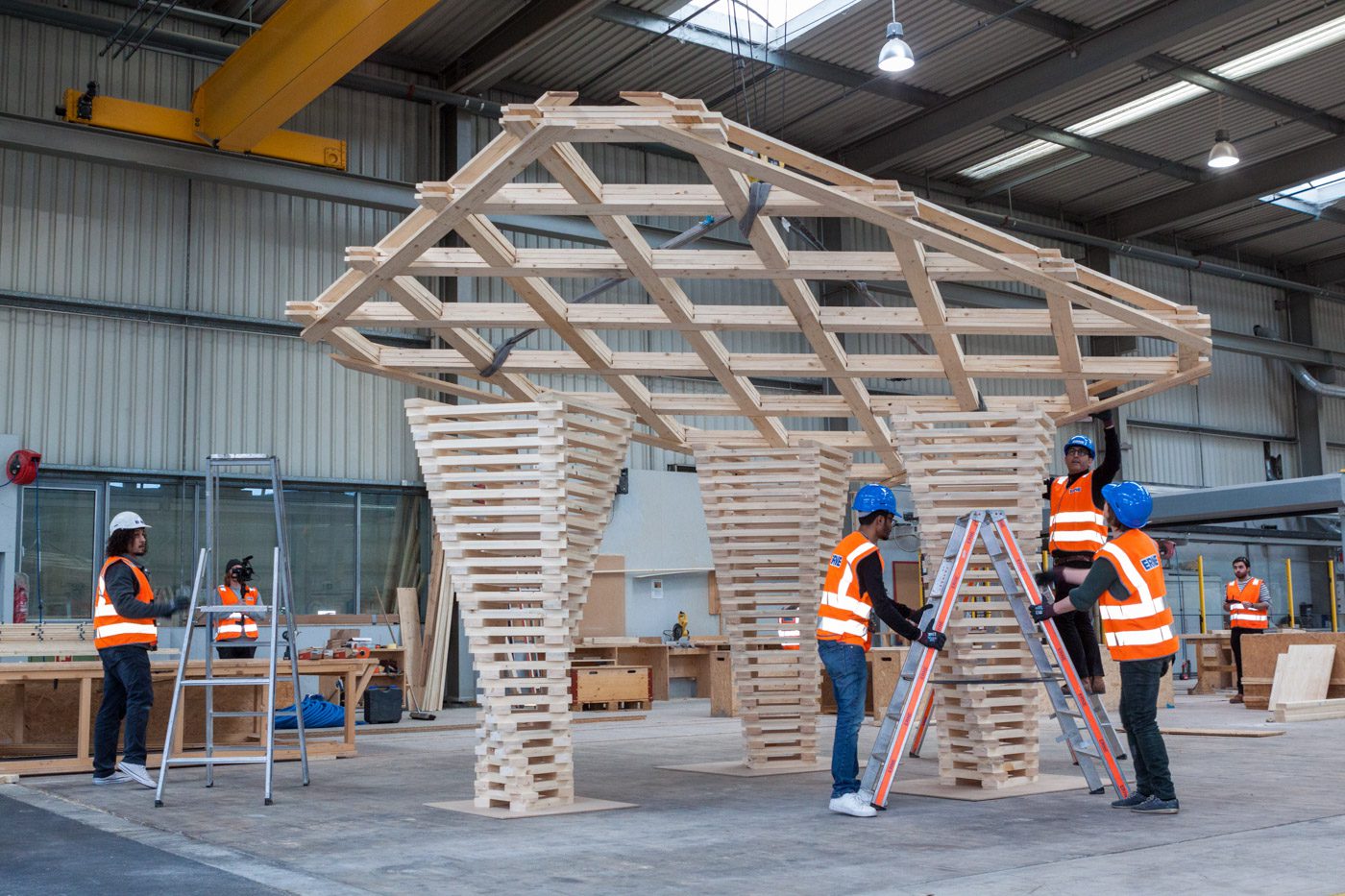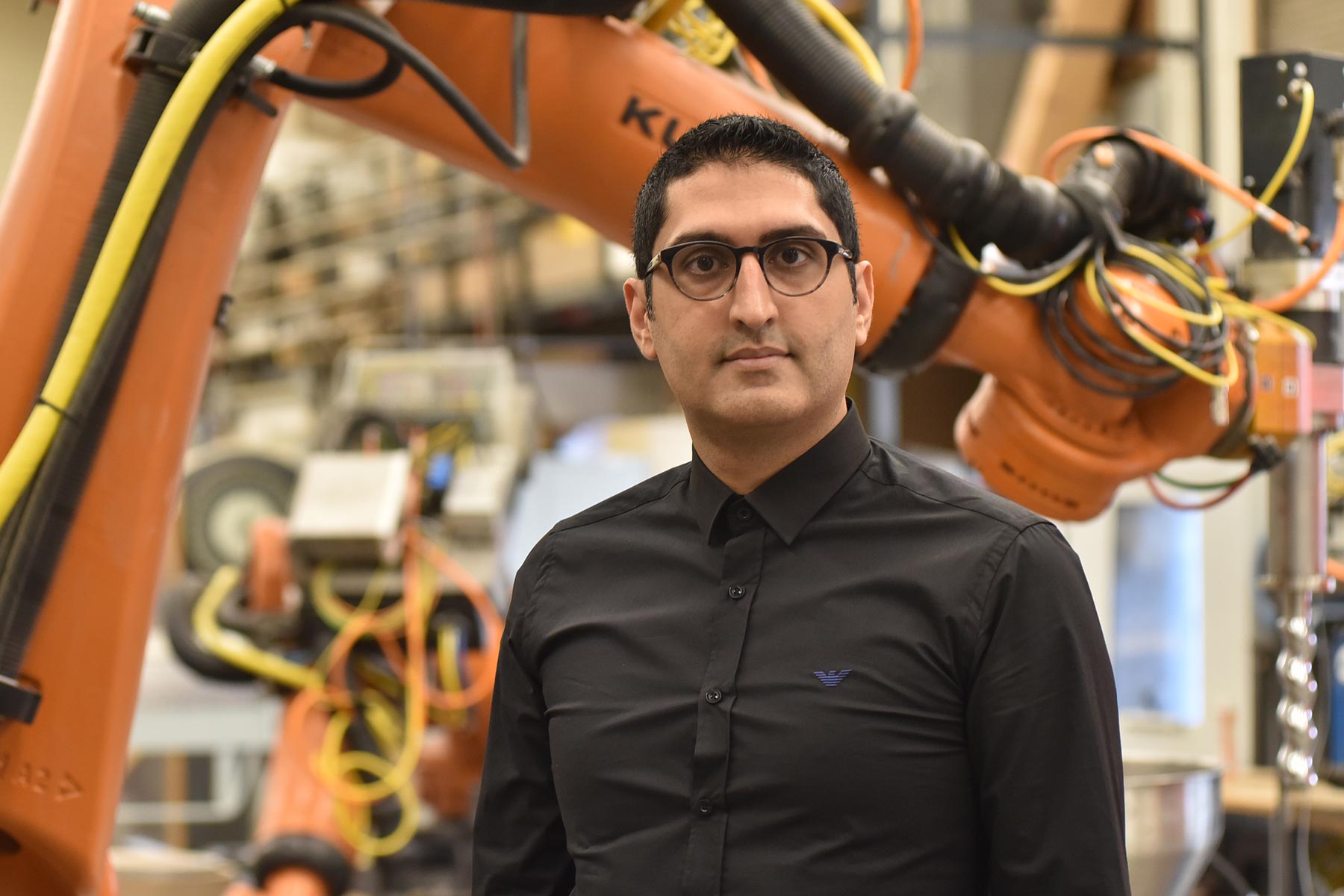Automation has already transformed major industries, such as automotive manufacturing, medical science, and telecommunications.
However, architectural design and construction are still playing catch-up.
At Taubman College, Arash Adel is ushering those intertwined industries into the Automation Era through leading-edge research and teaching at the intersection of computational design, engineering, and robotic construction.
“We are rethinking the future of architectural design and construction in response to the expansion of automation,” says Adel, an assistant professor of architecture. “At the same time, we are preparing our students for this shift toward automation in their own careers.”
Adel envisions a future where timber-frame construction, both off-site and on-site, will be a collaborative process between humans and robots. This vision requires reevaluating the traditional phase-based architectural-design process and developing integrative design processes and digital design-to-fabrication workflows.
Under this scenario, architects gather together all the pertinent input on structural design, engineering, manufacturing, and assembly at the start of a project and use these criteria to develop a computational design model. They then upload the model into industrial robotic arms that fabricate timber-frame building components.
Once completed, the prefabricated modules are transported from the factory floor to the building site. There, architects and others involved in the building process employ specialized XR (extended reality) headsets and custom algorithms to superimpose architectural-design information on the physical structure of the building. This spatial visualization potentially enables them to assemble the prefabricated modules more effectively without the need to use conventional drawing sets.
While this human-robot collaboration process may sound somewhat futuristic, it is actually closer to reality than it appears.
“In our research, we have developed the means and methods to apply integrative computational design techniques and robotic assembly processes to housing,” Adel says.
As a doctoral candidate at the Swiss Federal Institute of Technology in Zurich, he led the computational design for DFAB House, a robotically fabricated timber-frame structure that officially opened in February 2019.
Adel joined Taubman College in 2019 as a postdoctoral fellow became an assistant professor in July 2020. In January, he established Adel Design Research (AdR), an interdisciplinary laboratory for advanced research in architecture, computational design, and robotic construction. One of AdR’s main objectives is to work with industry to integrate its innovative research into building practice.
At Taubman, Adel is teaching graduate students the building blocks of integrative computational design and robotic assembly at the college’s state-of-the-art Digital Fabrication Lab, a.k.a. FABLab.
“We are helping students build their foundational skills by applying robotic-fabrication techniques to building components, such as wall and floor modules,” Adel explains.
Last year, he took students in the Master of Science in Digital and Material Technologies program to Switzerland for a collaborative workshop with ERNE AG Holzbau at the company’s fabrication facility in Stein. In just three days, the team manufactured and assembled a unique timber pavilion. They used a KUKA KR240 industrial robotic arm to cut, place, and join stacked-timber slats for the pavilion’s three support columns and a 7-axis gantry system to assemble a lattice-style layered roof.

In collaboration with ERNE AG Holzbau, Arash Adel organized a Robotic Timber Assembly Workshop for Taubman College’s Master of Science in Digital and Material Technologies cohort. They traveled to Switzerland in February.
Recently, Adel received an XR Innovation grant from U-M’s Center for Academic Innovation. The grant will accelerate the use of emerging XR technologies ― such as Microsoft’s augmented-reality HoloLens 2 goggles ― to teach robotic construction to architect and engineering students and to advance human-robot collaboration.
“This grant will help to bridge the gap between the 3D modeling environments used to design architectural projects and the physical construction process,” Adel says.
The marriage of intelligent modeling and intelligent manufacturing will allow architects to mass customize buildings with more or less the same efficiency as conventional mass production.
“People living in different regions, climates, and cultures have different needs, requirements, and preferences, so it is not efficient nor culturally appropriate to construct standard buildings everywhere,” Adel explains. “The coupling of custom generative algorithms and nonstandard robotic fabrication enables the efficient customization of buildings to the specific needs of users.”
There are also potential environmental benefits to be gained by automating the manufacture of timber-frame structures. For one, wood sequesters carbon whereas steel and concrete generate carbon that contributes to harmful greenhouse gases.
“We work with locally sourced lumber that has been sustainably managed and harvested,” Adel says. “Wood has a low-carbon footprint, which is important in mitigating global warming.”
How quickly the architecture and construction sectors will adopt and implement automation is anybody’s guess. However, the payoff for U-M graduates who have skills and training to work collaboratively with robots is already apparent.
“Last year when COVID-19 struck, some architecture firms furloughed their employees,” Adel says. “But the students who graduated from our program received multiple job offers from custom-design and advanced-fabrication firms.”
― Claudia Capos





